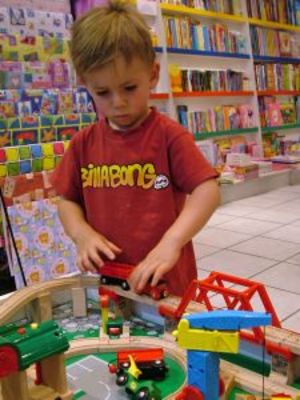Parent’s and child care providers don’t always think about the reasons for why they suddenly decide to purchase a new toy. They see it in the store and they decide to buy it. It sounds rather simple, but what they don’t understand is that companies market their products to make the toys, especially those made for infants and toddlers, more appealing to parents. Bright, colorful packaging with pictures that show the children happily enjoying the toy usually real parents in quickly. If the companies are smart, they also provide a list showing what that toy accomplishes when children play. Parents want their children to learn, and toys that promote, cognitive, emotional, and social development grab the attention of parents, especially new, rather quickly.
I looked at some of the newest and most popular toys available on the market for children ages 0-36 months. I’ll show you what brings people in, my thoughts on what the toy can accomplish, and whether or not I’d recommend it.
The Learning Piggy Bank
The packaging for this toy is bright and colorful and showed children happily playing with the toy. It showed them picking up the pieces, and smiling at the colorful lights, in a sense, it seems they really enjoyed it. It claims to help the children begin to learn their numbers, colors and shapes. I think the toy would help cognitive and physical development a bit because if parents/caregivers get involved in the toys, they can help foster their cognitive development, and it helps their physical development when they have to pick up the small pieces and work with it. The toy can either be used in solitary or child and caregiver play. I might purchase this toy for a center or a child of my own because it is colorful and eye grabbing, but some might not stay interested in it long.
Learning Puppy
The learning puppy also has a huge colorful box. The toy itself is displayed so parents can really try it out before they decide to buy. The toy is also colorful and claims that it helps with their cognitive development and promotes learning and exploration in the child. I think the toy would help the child in both of the above areas as the child will learn things as it pushes the buttons on the puppy. The toy may need to be used with a caregiver as not all children can push buttons yet. As the child becomes older and has stronger muscles, solitary play may be possible. I would purchase this toy as it seems to be a wonderful tool for catching the attention of children. However, a lot of caregiver interaction would be needed to be sure that the child did not become confused with how the sayings for each button pushed changed often. You would have to restate what it was teaching and point it out.
Spell and Learn Fun Set
The pieces are large, and this can be seen through the packaging. The box is plain colored, but on the back, it shows a child piecing together the puzzle pieces to spell whatever the picture piece indicates at that time. This toy claims to help with cognitive development with learning to identify pictures and learning to how to spell very simple words. I believe the toy would help a child develop cognitively but I also believe it would help a bit with physical development because it would help them work on their small muscles in their hands. This toy can be used solitarily, but for maximum learning to take place, it should be used with a caregiver. I would purchase this toy for my center and/or my child. However, I’d be sure that someone was always around to help the child learn better.
Busy Lil Honey Bee
Parents are encouraged by the bright packaging and buy the pictures on the box to buy the toy because the children featured look like they are really enjoying the product. It’s not a bulky toy either which should appeal to parents who want small, carrying type toys for their children. The box claims to provide a child with discovery and exploration skills. It helps them take their learning into their hands. I think the toy would be great for physical development in the way that it helps them do a lot of muscle work by pulling and carrying the toy around. This toy can be used in solitary play, it does not seem to really reinforce in child/caregiver type bonding. However, I do not think I would by this toy for my child care center, as the toy is too soft, and cannot be easily cleaned, nor does it provide bonding time between child and caregiver.
Gloworm
The packaging is bright, and parents see that it is supposed to be a calming soothing toy for children to use at bedtime. The box reinforces the ideas that the toy is cuddly, encourages tenderness and is the perfect companion for children. The toy claims to really help with emotional development in the way of having a bedtime companion with them at all times. I believe the toy would foster emotional development as this toy can really be comforting for them at night. It plays music therefore can help lull a child to sleep, and it’s something for them to grasp in the middle of the night for a quick hug. This is more of a solitary type toy. I would buy this for my child, or for my child care center to help children during nap times. They’d really enjoy having something to hold onto and cuddle with during nap or sleep times.
Dual Start Dragway
Packaging really only shows children enjoying the toy, it shows them taking control of their play experience. It also gives parents the opportunity to feel what the cars feel like. It does not claim to offer and developmental assistance, but I think it would really help their cognitive development as kids will learn that doing one thing will cause another to happen, as they have to pull back and push buttons to launch cars on a race track. They will learn that things happen because other things cause them. The toy can be used in solitary or interactive play. It offers two race tracks so people can play side by side. I would purchase this for my center as it can be a beneficial toy for children learning how to accomplish tasks.
Busy Elephant
The packaging shows children enjoying the toy and even interacting with caregivers/parents during play time. Parents should find that appealing. The packaging claims that it encourages bonding, exploration and play. I believe the toy would definitely help with cognitive and emotional development. The elephant has to be pushed and touched and can allow a child to explore the many different areas on the toy. Parents can help the child during play, which helps them with bonding with their parents. The toy can be used either for solitary or interactive play. I would purchase this toy for my children or my center as I think the children would really like exploring and playing with caregivers that can really get them involved in their learning and play time.
Tigger Activity Spiral
The toy packaging is rather plain and only offers one picture of a child playing with it on their carrier. The toy says it encourages exploration, and it does. It would help with their cognitive and physical development. The toy has several different textured surfaces, and noises accompany certain areas when touched. The child can explore the toy by itself, but younger children will need assistance to become interested in the toy. So this toy really is more for solitary play. I would purchase this toy as it can give the child something eye catching and friendly to look at and gives them chances to explore.
Rhyming Mirror
The package tells parents that children can learn through play, and explains what exactly the child can do during play. Parents are encouraged by that, and by the large picture on the back to purchase the toy. Box claims that children will explore and enjoy the lights, sounds and motions of the toy. Children can learn here through cognitive development. They learn that pushing a button or pulling a lever will cause another thing to happen such as music or singing. The toy can be used for either solitary or interactive play, but children will probably want to do more exploring on their own after a caregiver shows them how to do things once or twice. I would buy this toy as children are captivated by the toy’s colors, shapes and sounds. I think they would learn a lot about colors, shapes and the words to songs, they would also learn how to identify themselves by looking into the mirror.
Munchkin
This toy doesn’t really show too much, so parents aren’t encouraged by the packaging to buy the toy, they are more encouraged by the toy itself. The toy has many textures and sounds for the child to explore. It has many uses; it’s a teething ring and a toy all in one. I think that cognitive development would really be helped by this toy, as would emotional development. They can explore the toy and chew on it, as well as have caregivers nearby to talk soothingly to them especially if they are in a lot of pain. The toy is designed more for solitary play, as the caregiver doesn’t have anything to become involved in. I would purchase this toy as it can be comforting to a child that needs it, and it does offer many ways for the child to explore and learn through their senses.



